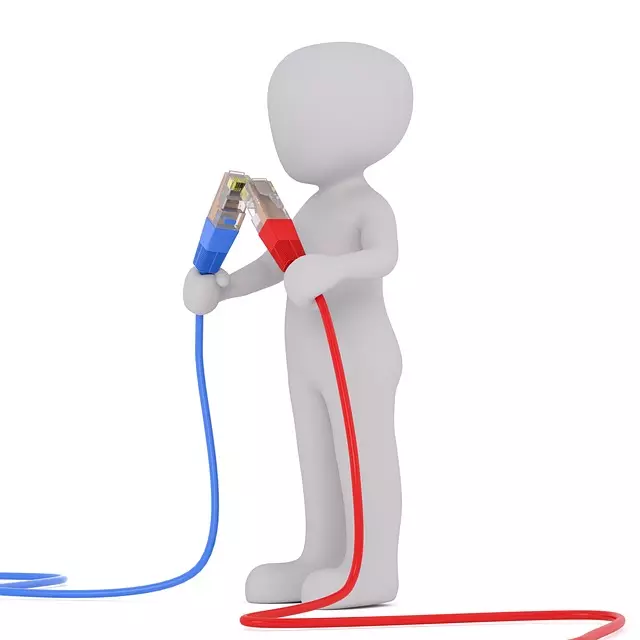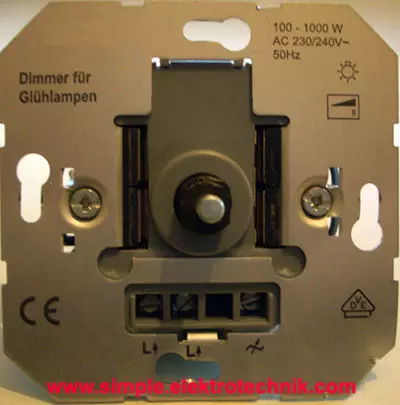Instructions for Installing and Connecting a Dimmer:
A dimmer is a special type of electrical switch that allows you to smoothly adjust the brightness of a lamp or other electrical load. Unlike a conventional on/off switch that only has two states (On and Off), a dimmer provides the possibility to vary the light intensity or power of the connected lamp.
A typical dimmer features a rotating or sliding control that can be used to adjust the brightness. Depending on the position of the control, the lamp becomes brighter or dimmer. The dimmer works by altering the voltage supplied to the lamp. Lower voltages result in a dimmer light, while higher voltages make the lamp brighter.
Using a dimmer offers various advantages, such as the ability to tailor the lighting to specific needs and moods, save energy, and extend the lifespan of the lamps.
It's essential that the dimmer is compatible with the electrical load that will be connected to it. Not all lamps or light sources can be operated with any dimmer. It is advisable to follow the manufacturer's specifications and recommendations to ensure a safe and proper use of the dimmer. Additionally, relevant electrical safety regulations and installation guidelines should be adhered to in order to avoid accidents or damage.
Structure and Function of a Dimmer:
A dimmer is a specialized electrical switch that allows you to smoothly adjust the brightness of a lamp or other electrical load.
Unlike a conventional on/off switch that only has two states (On and Off), a dimmer provides the ability to adjust the light intensity or power of the connected lamp as needed.
The construction of a dimmer typically involves three connections:

- The two input terminals: This connection is linked to the line conductor (phase) of the circuit.
- The output terminal: This allows the connection to the electrical load, such as a lamp.
The dimmer can also be represented with a special symbol resembling a stylized light bulb, with a small triangle underneath, representing the continuous adjustment.
The function of a dimmer is based on the arrangement of contacts in the circuit. In one position of the dimmer, the input terminal is connected to one of the output terminals, while the other output terminal is disconnected. This allows the full voltage to flow to the lamp, and it shines at maximum brightness.
By operating the dimmer or turning the knob, the connection is switched. The input terminal is then connected to the other output terminal, and the previous connection to the first output terminal is disconnected. This reduces the voltage supplied to the lamp, and thus the brightness of the lamp is reduced.
This means that depending on the position of the dimmer, the lamp can shine brighter or darker, allowing you to adjust the lighting according to specific needs or moods. However, it is essential to select the dimmer correctly based on the electrical load, such as the type and wattage of the lamps, to ensure proper operation and safe functionality. Moreover, all electrical safety regulations and installation guidelines should be followed carefully to avoid potential accidents or damages.
Proper Connection of a Dimmer:
The correct connection of a dimmer requires careful handling to ensure proper operation and safe functionality. A clear and understandable instruction is essential to perform the wiring effortlessly. Here is a straightforward guide for the correct connection of a dimmer:

- Remove the cover of the switch box where the dimmer will be installed to access the terminals.
- Take note of the positions of the terminals on the dimmer. Typically, there are three terminals: the input terminal (L), the output terminal (∼), and in some cases, an earthing terminal (PE) for protective grounding.
- Connect the phase wire (live wire) of the circuit to the input terminal (L) of the dimmer.
- Connect the output terminal (∼) of the dimmer to the phase of the load, such as the lamp or any other electrical source.
- If available, connect the earthing terminal (PE) of the dimmer to the protective grounding of the circuit. Protective grounding is essential to ensure electrical safety.
- Carefully check if all connections are firm and secure. Use appropriate connection clamps or screw connections.
The correct connection of a dimmer requires attention to detail and following the precise wiring instructions provided by the manufacturer. By connecting the appropriate terminals according to the product description and establishing the correct connection to the lamp or electrical load, ensure that the dimmer functions flawlessly, and the lighting can be smoothly regulated.
If uncertain or in need of assistance, it is advisable to consult a professional electrician to avoid potential errors or hazards. Improper installation of a dimmer can lead to electrical issues, damages, or even injuries. Safety should always be the top priority when dealing with electrical installations.
Front View of the Dimmer

Phase (L) Output to the Lamp
Back View of the Dimmer

Instructions for Installing and Connecting a Dimmer:

- Ensure that the power supply to the circuit where the dimmer is to be installed is turned off. Turn off the corresponding circuit breaker or remove the fuse to ensure a safe working area.
- Take the dimmer out of the packaging and check if it is complete and undamaged. Also, read the dimmer's user manual to familiarize yourself with its features and connections.
- Remove the cover of the switch box to access the wiring. Note that some dimmers may require a deeper switch box to accommodate the additional wiring.
- Identify the terminals on the dimmer. Usually, there are three terminals: the input terminal (L), the output terminal (∼), and, if available, the earthing terminal (PE) for protective grounding.
- Refer to the manufacturer's circuit diagram to identify the correct terminals. The input terminal is usually labeled as "L" or "Phase," while the output terminal may be labeled as "L˜" or "∼".
- Connect the input terminal (L) of the dimmer to the phase wire (live wire) of the circuit. Ensure the connection is firm and secure.
- Connect the output terminal (∼) of the dimmer to the phase of the load to be controlled, for example, a lamp or another electrical consumer source.
- If available, connect the earthing terminal (PE) of the dimmer to the protective grounding of the circuit. This is crucial to ensure electrical safety.
- Carefully check if all connections are firm and secure. Use appropriate connection clamps or screw connections.
- Reattach the cover of the switch box.
- Turn the power supply back on by switching on the circuit breaker or inserting the fuse.
- Test the dimmer to ensure it works correctly. Turn or operate the dimmer to adjust the lighting smoothly and regulate the brightness.
Important: If you are unsure or have no experience with electrical installations, it is advisable to seek assistance from a qualified electrician to perform the installation correctly and safely. Improper installation of a dimmer can lead to electrical problems, damages, or injuries. Safety should always be the highest priority when working with electricity.

Dimmers have various applications in electrical engineering.
Here are some examples:
Dimmers have diverse applications in electrical engineering, enabling the continuous adjustment of the brightness of lamps or other electrical loads. Here are some examples of their applications:
- Lighting control. Dimmers allow adjusting the brightness of lamps in living rooms, offices, restaurants, or other places to adapt the lighting to specific needs and moods.
- Interior design. With a dimmer, the atmosphere of a room can be altered by varying the lighting intensity to create a cozy, romantic, or relaxed environment.
- Light effects. Dimmers can be used in artistic and decorative applications to produce special light effects or set accents.
- Energy saving. The use of dimmers enables adjusting the light intensity, thus saving energy, especially in situations where full brightness is not always necessary.
- Extending lamp lifespan. By reducing the brightness, the lifespan of lamps can be extended as they are subjected to less thermal stress.
- Glare limitation. In rooms with large windows or strong light sources, a dimmer can be employed to reduce glare and enhance visual comfort.
- Presentations or events. Dimmers are used in stage shows, theater performances, or conferences to adapt the lighting to specific needs and focus attention on certain areas.
- Safety and securing lighting scenarios. Dimmers allow creating and saving various lighting scenarios to recall specific lighting moods or configurations at any time.
Overall, dimmers offer flexibility and adaptability for controlling lighting in various applications, creating a comfortable, energy-efficient, and aesthetically pleasing environment.
Elektrosicherheit: Richtlinien und Vorsichtsmaßnahmen für einfache elektrotechnische Arbeiten
Die Sicherheit hat oberste Priorität.

- Alle hier bereitgestellten Anleitungen und Informationen dienen rein informativen Zwecken und sollen ausschließlich zur Informationsbeschaffung und Weiterbildung verwendet werden. Sie sollten nicht als Ersatz für professionelle Beratung angesehen werden. Bei Zweifeln empfiehlt es sich, einen qualifizierten Elektriker hinzuzuziehen, um fachkundige Unterstützung zu erhalten.
- Es ist wichtig, die örtlichen Vorschriften und Bestimmungen bei elektrischen Arbeiten zu beachten. Arbeiten mit Strom sollten nur von qualifizierten Fachleuten durchgeführt werden, da sie lebensgefährlich sein können.
- Fehler in Anleitungen und Schaltbildern sind möglich. Der Anbieter übernimmt keine Gewähr oder Haftung für Schäden oder Verletzungen, die aus der Umsetzung der bereitgestellten Informationen resultieren könnten. Es liegt in Ihrer Verantwortung, die Richtigkeit der Informationen zu überprüfen und die erforderlichen Sicherheitsvorkehrungen zu treffen.
- Die Verwendung geeigneter persönlicher Schutzausrüstung (PSA) ist entscheidend, um die Sicherheit bei elektrotechnischen Arbeiten zu gewährleisten. PSA schützt vor Stromschlägen, Augenverletzungen, thermischen und mechanischen Gefahren. Es ist jedoch wichtig zu beachten, dass PSA allein nicht ausreicht und durch Fachwissen, Fähigkeiten und die Einhaltung von Sicherheitsvorschriften ergänzt werden muss.
- Arbeiten an Teilen, die unter Spannung stehen, sind strengstens untersagt. Vor Beginn der Arbeiten müssen geeignete Sicherheitsvorkehrungen getroffen werden, einschließlich des Freischaltens der Anlage.
- Bei Schäden durch mangelhafte Elektroinstallation haftet der Errichter der Anlage gemäß den geltenden gesetzlichen Bestimmungen.
- Diese Zusammenfassung von Richtlinien und Vorsichtsmaßnahmen ist nicht umfassend. Bei Unsicherheiten ist es ratsam, einen qualifizierten Elektriker zu konsultieren oder sich an örtliche Vorschriften und Bestimmungen zu halten, um maximale Sicherheit zu gewährleisten.
- Die ordnungsgemäße Installation und Wartung von elektrischen Anlagen und Geräten ist von großer Bedeutung, um mögliche Gefahren zu minimieren und ein sicheres Umfeld zu schaffen.